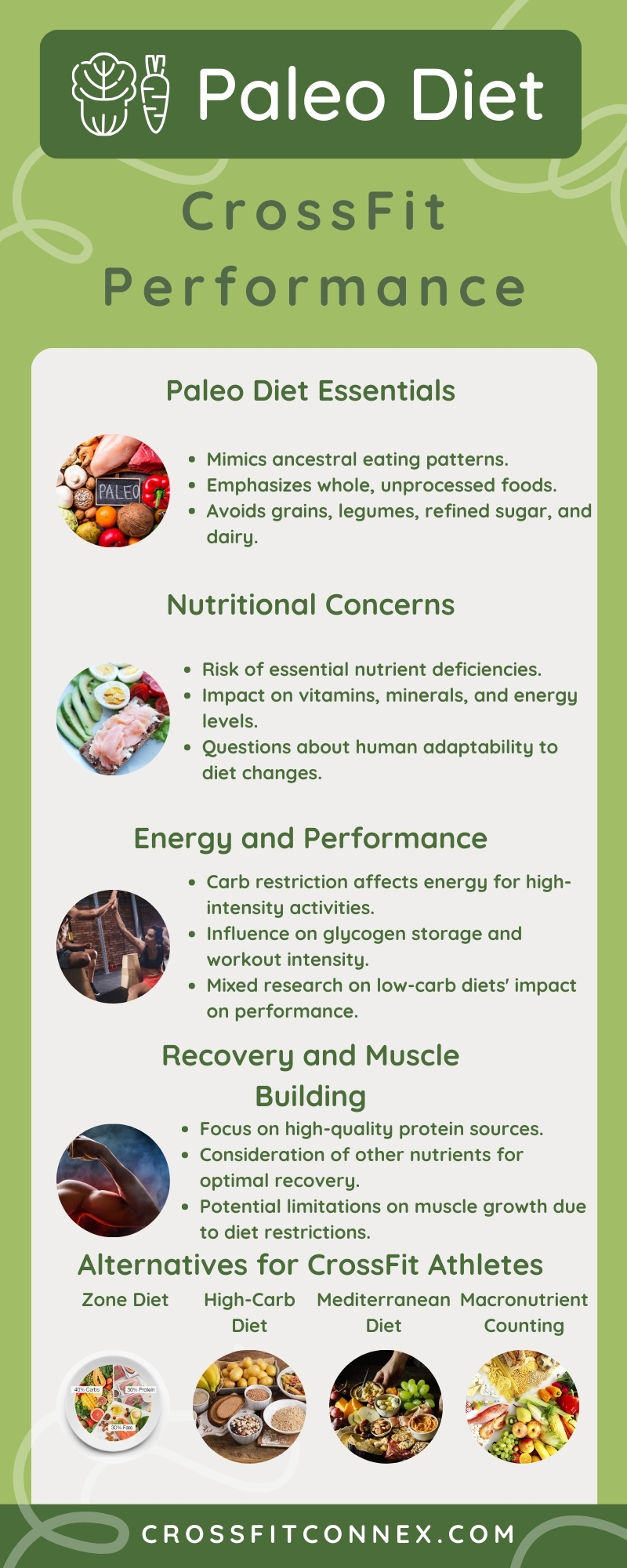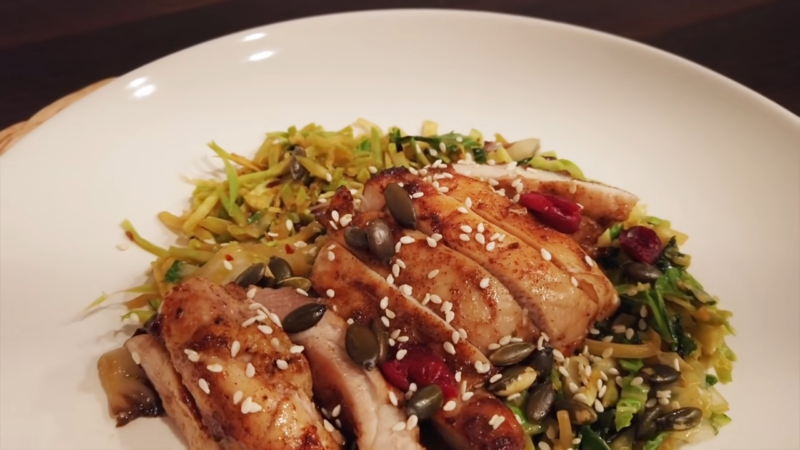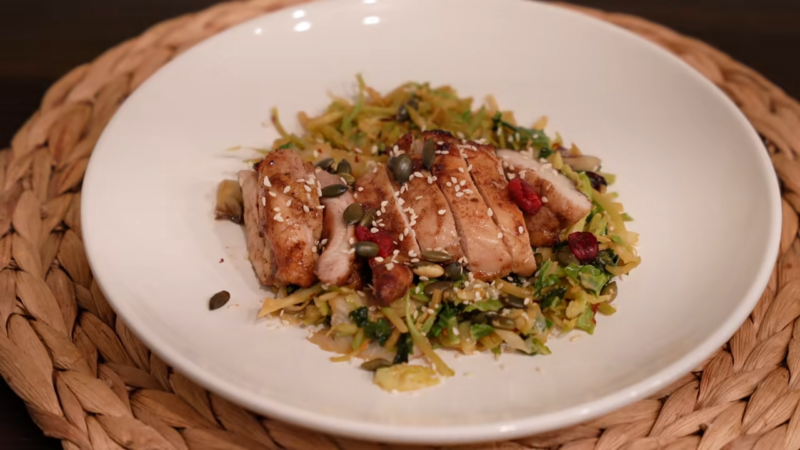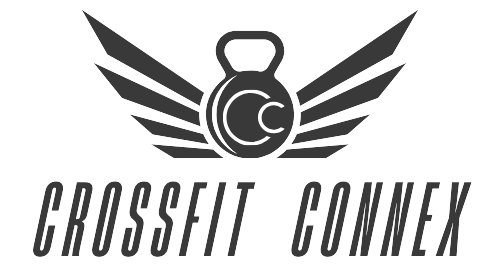In recent years, the Paleo Diet gained popularity among fitness enthusiasts, particularly those involved in CrossFit. This diet, inspired by the eating habits of our Paleolithic ancestors, emphasizes consuming whole foods such as meats, fish, nuts, leafy greens, regional veggies, and seeds, while strictly avoiding grains, legumes, refined sugar, and dairy.
The idea is to stick to the basics, focusing on whole, unprocessed foods to improve health and fitness.
Proponents argue that it leads to a healthier lifestyle, more in tune with our genetic predispositions. However, CrossFit demands high intensity, variability, and heavy lifting, so the Paleo Diet’s restrictions bring about significant concerns.

1. Nutritional Concerns and Limitations

Adopting the Paleo Diet can lead to notable shifts in one’s nutritional intake due to the exclusion of entire food groups such as grains and legumes, which are staples in many diets around the globe. This exclusion raises concerns about potential nutritional deficiencies that could have a significant impact on an individual’s health, athletic performance, and recovery capabilities.
Vitamins and Minerals Intake are at Risk
Grains and legumes are rich sources of essential nutrients, including B vitamins (particularly folate), which are crucial for energy production and the maintenance of brain health. They also provide dietary fibers, iron, magnesium, and selenium.
The absence of these foods in the Paleo Diet might result in a lower intake of these vital nutrients. Iron, for example, is critical for the production of hemoglobin, which transports oxygen to our muscles, a fundamental process for athletes aiming for peak performance.
Similarly, magnesium plays a pivotal role in muscle function, energy production, and the management of blood sugar levels and blood pressure.
According to Brian St. Pierre, a Registered Dietitian (RD) and the Director of Nutrition at Precision Nutrition, the human microbiome’s ability to adapt rapidly to dietary changes challenges the Paleo Diet’s belief. This adaptability suggests that modern humans might process “non-Paleo” foods like grains and dairy more efficiently than assumed, thanks to evolved gut bacteria.
2. Impact on Energy and Performance

The Paleo Diet’s restriction of carbohydrates, which are eliminated through the avoidance of grains, legumes, and processed sugars, significantly impacts an athlete’s energy levels and performance, particularly in high-intensity sports like CrossFit.
Carbohydrates are the body’s preferred fuel source, especially during short, intense bursts of activity characteristic of CrossFit workouts, which include a mix of aerobic exercises, weightlifting, and other high-intensity movements.
Energy Production and Glycogen Storage
Carbohydrates are stored in the muscles and liver as glycogen, which is quickly mobilized during high-intensity exercise to provide energy. Restricting carbohydrate intake can consume glycogen stores, leading to decreased performance, increased fatigue, and a longer recovery time. This is crucial for CrossFit athletes, who rely on short, powerful bursts of energy to complete workouts effectively.
Studies and Expert Opinions

Research has shown mixed results regarding low-carbohydrate diets and athletic performance. For instance, a study published in the “Journal of the International Society of Sports Nutrition” suggests that while a low-carb diet may benefit long-duration, low- to moderate-intensity exercise, it might not be as effective for high-intensity activities, which are more reliant on glycogen stores.
Experts in sports nutrition often advocate for a personalized approach to diet, encouraging an optimal carbohydrate intake that can vary widely among individuals, depending on the intensity and duration of their training and their body’s response to different diets.
Adaptation Period and Ketosis
Some proponents of low-carb diets argue that the body can adapt to using fat as its primary energy source, a state known as ketosis. However, achieving and maintaining ketosis requires strict adherence to a very low carbohydrate intake, and the transition can be challenging, marked by symptoms like fatigue, headache, and decreased performance.
According to a Journal of Sports Nutrition and Exercise Metabolism study, there is an increased risk of iron and calcium deficiencies in athletes who consume the Paleo Diet. The research was conducted on 200 athletes over 12 months to assess changes in performance, muscle function, and blood nutrient levels compared to a control group on a balanced athletic diet.
3. Recovery and Muscle Building

The Paleo Diet’s focus on high-quality, whole-food sources of protein, such as meats, fish, and eggs, aligns well with the needs of athletes focused on muscle recovery and growth. These protein sources are rich in essential amino acids, which are critical for the repair and building of muscle tissue, especially after the rigorous demands of CrossFit workouts.
However, the diet’s exclusion of certain food groups, such as dairy and grains, which can also contribute to protein intake, raises questions about its overall efficacy for optimal muscle recovery and growth in athletes.
Protein Quality and Quantity
The proteins found in animal products are considered high-quality because they contain all nine essential amino acids necessary for human health. For CrossFit athletes, who often require a higher protein intake to support muscle repair and growth, the Paleo Diet can provide adequate quality protein.
However, the quantity of protein needed varies depending on factors such as weight, the intensity of training, and personal goals.
Supplements such as whey protein or branched-chain amino acids (BCAAs) can be beneficial for CrossFit athletes looking to optimize their protein intake and recovery, especially during intense training periods.
The Role of Other Nutrients in Recovery

Muscle recovery is not solely dependent on protein intake. Other nutrients, such as carbohydrates and certain vitamins and minerals excluded or limited in the Paleo Diet, play significant roles in the recovery process. Carbohydrates, for example, are crucial for replenishing glycogen stores consumed during exercise.
The restriction of grains and legumes, both excellent sources of complex carbohydrates, might prolong recovery. The absence of dairy products, a source of calcium and vitamin D, might impact bone health and muscle function.
Impact on Muscle Growth
Muscle growth occurs when muscle protein synthesis exceeds muscle protein breakdown, a process heavily influenced by the availability of amino acids from dietary protein. While the Paleo Diet provides ample protein from animal sources, the diversity of amino acids might be limited compared to a diet that includes a broader range of protein sources.
The energy deficit from a lower carbohydrate intake could be used for producing more energy rather than for muscle repair and growth.
Experts engaged in the Paleolithic Diet study published in the journal “Nutrients”, provide a comprehensive analysis of the Paleo Diet’s influence on the performance of professional athletes. Despite recognizing some health benefits of the Paleo Diet, the study underscores the need for longer-term interventions to determine its effects on athletic performance. This critical review suggests more rigorous research before recommending the Paleo Diet to athletes.
4. Long-term Impact of Paleo Diet on Athletes

When considering the long-term flexibility and sustainability of the Paleo Diet for athletes, particularly those involved in rigorous training regimes like CrossFit, several challenges occur:
Sustainability
One of the main concerns regarding the Paleo Diet’s long-term sustainability is its restrictive nature. The complete elimination of grains, legumes, dairy, and processed sugars can be challenging to maintain over time, especially for athletes who require a diverse and flexible diet to meet their changing nutritional needs.
Adaptability to Training Demands
CrossFit athletes face varying demands based on their training cycles, competition schedules, and individual recovery needs. The Paleo Diet’s rigidity might not offer the necessary flexibility to adapt to these changing energy and nutrient requirements.
For instance, periods of intense training or competition may necessitate increased carbohydrate intake for optimal performance and recovery, challenging the low-carb nature of this diet.
Athletes might find it necessary to modify the diet to include non-Paleo carbohydrate sources to meet their energy needs, which could detract from the diet’s original model.
Psychological Impact

The psychological aspect of adhering to a strict diet like this over the long term cannot be overlooked. Dietary restrictions lead to an unhealthy relationship with food, where the focus shifts from nourishment and enjoyment to compliance and restriction.
For athletes, this mindset could not only diminish the joy of eating but also potentially lead to stress and anxiety around food choices, impacting mental health and overall well-being.
5. Alternative Nutritional Strategies
When exploring nutritional strategies suitable for athletes, especially those engaged in CrossFit, it’s beneficial to compare the Paleo Diet with other dietary approaches that emphasize balanced nutrition, energy management, and optimal recovery.
Considering specific pre and post-workout nutrition tailored for CrossFit athletes is also crucial, as it directly impacts performance and recovery.
These alternatives often provide a more flexible model, catering to the dynamic needs of athletes.
| Dietary Approach | Key Characteristics | Benefits for CrossFit Athletes |
|---|---|---|
| Zone Diet | 40% carbohydrates, 30% protein, 30% fats. Aims to balance blood sugar and reduce inflammation. | Provides structured, flexible eating that can be adjusted based on activity level and goals. |
| High-Carbohydrate Diet | Emphasizes grains, fruits, vegetables, and legumes for energy. | Supports glycogen stores for endurance and high-intensity efforts. |
| Mediterranean Diet | Rich in fruits, vegetables, whole grains, and healthy fats, with moderate fish and poultry. | Offers balanced nutrition and variety, though may require additional protein. |
| Macronutrient Counting (IIFYM) | Focuses on hitting specific daily macronutrient targets. | Allows flexibility in food choices, adjustable to individual energy and recovery needs. |
Each of these dietary approaches offers unique benefits and challenges for CrossFit athletes. The key to selecting the most appropriate diet lies in considering individual nutritional needs, lifestyle factors, training goals, and personal preferences. Consulting with a sports nutritionist can help athletes navigate these choices, tailoring their diet to optimize performance, recovery, and overall health.
Final Thoughts

The long-term sustainability and flexibility of the diet were questioned, given its restrictive nature and the challenges it presents in adapting to the varied nutritional needs of athletes. Despite these concerns, this diet has its proponents within the CrossFit community, attracted by its focus on clean eating and the benefits reported by some athletes.
Research and expert opinions provide a slightly different view, indicating that while the Paleo Diet may offer benefits in terms of body composition and health markers, its strict food exclusions face significant issues. The effectiveness and suitability of this diet for athletes depend on individual factors, including gut microbiome adaptability and personal dietary tolerances.
While the Paleo Diet has found favor among many in the CrossFit and broader fitness communities, it’s clear that it’s not a one-size-fits-all solution. Athletes and individuals considering this diet should weigh its potential benefits against the drawbacks, including nutritional deficiencies and impacts on performance and recovery.
Personalization of the diet to meet individual nutritional needs, along with consultation with nutrition experts, can help overcome these challenges.



